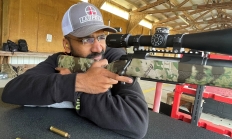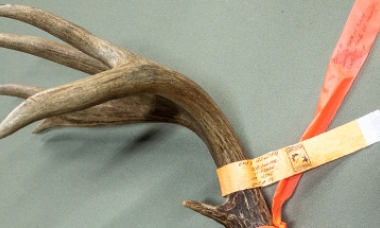
Search myodfw.com
Turkey hunters using a shotgun face a very small target – the head and neck of a turkey. Combine that with today’s specialized turkey loads shooting very tight patterns, and making a clean kill shot might depend on a steady shooting rest. Turkeys are nervous-looking birds that seem to never stop moving. Because of their monocular vision and eyes set on the side of their skull, turkeys are often moving and bobbing their heads to try to decipher what they’re seeing. Consider a shooting rest If you’ve got your gun in a ready position, and are waiting for a turkey

Before shooting a bow, you’ll want to make sure it's safe to fire. Bow/arrow safety check list Check that the string and cable are in good condition and aren ’t rubbing or fraying at any point. Use bowstring wax regularly to keep your string in good condition and safe to shoot. Check that the cams, limbs and riser are all in good shape. Look for cracks, dents, breaks, delaminations, peeling fiberglass, and any mechanical parts that may be defective. If any part of the bow is suspect, don’t shoot it. Fix it or take it to an archery shop to

Practice shooting your bow regularly and you’ll develop the form and muscle memory you need to shoot accurately and confidently. Places to shoot from the backyard to the backcountry You can practice your shooting anywhere it’s safe and outside of urban growth boundaries. It's also illegal to shoot in the direction of any person, building, structure or vehicle within the range of your bow. So be sure there's y a clear line of sight between you and the target, and a safe backstop. Possible locations include: A large backyard in a rural setting Archery specific indoor and outdoor target ranges

To be an accurate shooter, it’s important to develop a consistent grip and draw. One of the most common mistakes bowhunters make is tensing up and gripping the bow too firmly. A firm grip will torque the bow, or send it out of alignment, resulting in a poor shot and perhaps a painful slap on your arm from the bow string. Develop a consistent grip The grip of the bow should rest on the pad of your thumb and should not cross the lifeline of your hand. With the bow in this position, your fingers will be off to the


Turkey anatomy plays a big part in determining shot placement with a bow. Knowing where vital organs like the heart and lungs are will help you make a clean shot. Sometime getting to the vital organs may mean going through bone. In fact, a shot to the spine will drop a turkey quickly. But turkey bones are very strong, despite being hollow. That’s why many experienced archers prefer shooting a bow with a heavy draw weight, often the same setup they use for deer and elk hunting. Head shots, the most popular turkey shot for shotgun hunters, should be avoided

Shooting accurately starts with the proper form, and that begins with a good stance. From your feet up through your hips and torso, a solid foundation in your lower body will improve your shooting. Start with an open stance The “open” stance is a good one for beginners. It’s easy to master and to practice consistently. An open stance positions yours hips and shoulders in-line with the direction you ’re shooting. This perpendicular setup to the target is simple to do. First, place one foot on each side of the shooting line. Most ranges will have these lines. If not



Bowhunters can warm up for the archery season at free La Pine 3D shoot
SALEM, Ore. – Bowhunters can warm up for the archery season at a free 3D shoot in La Pine on Saturday, Aug. 2 at Three Rivers Archers Park located at the intersection of Coach Rd. and Memorial Lane. This unique course offers hunting scenarios and learning opportunities to help you prepare for the…

Statewide

Turkey hunters should be aware of all state hunting regulations, but pay special attention to these things – all of which are listed in the table of contents of the Oregon Game Bird Hunting Regulations: Licensing and tags Shooting hours Legal hunting methods Turkey hunting opportunities The Game Bird Regulations are available both online and in print, both are organized in the same way. Licensing and tags In Oregon, all hunters older than 12 years need a hunting license. Kids 12-17 years old can buy a special, value-priced youth license that also includes fishing and shellfishing. In addition to a

Shooting a target while standing up at the range is a lot different from shooting a turkey while sitting in a ground blind. When practicing for a hunting trip, recreate your shooting scenario. Whether it will be standing, sitting, kneeling, and in or out of a ground blind. Shooting a turkey There ’s no substitute for practicing in conditions that closely resemble those you’ll be hunting in, and this is especially true for bowhunters looking to bag a turkey. Turkeys are nervous birds with very small kill zones, so accurate shot placement is critical for getting a quick, clean kill

The E.E. Wilson Wildlife Area came into existence in 1950 when the U.S. Government gave quitclaim title to the property to the Oregon Department of Fish and Wildlife. The wildlife area covers approximately 1,788 acres, is located on Highway 99W about 10 miles north of Corvallis and is situated on the Willamette Valley floor. The shotgun range at E.E. Wilson Wildlife Area will be closed for renovation from July 14, 2025 through the end of October. Renovations on the range will include expanding the shooting bays and implementing ADA complaint access to the site. ODFW expects work to be complete
There are fundamental differences between turkey hunting with a bow and a shotgun, including effective range, shot placement and set up. Effective shooting distance Your effective shooting distance (how far you can be from a turkey and likely kill it with a single shot) will vary with the level of your shooting skills and the type of equipment you’re using. A good rule of thumb for shotgun shooters is 40 yards. Anything further than that and there’s a good chance you might not hit the head and neck with enough pellets to kill the bird. Any closer than 20 yards



There are basic rules of safety and etiquette that apply at archery ranges. Be sure you’re following them. Etiquette on the range Etiquette is an important part of a fun, positive and safe experience on the archery range. Proper range etiquette starts with safety, for you and others around you. Keep arrows pointed down range. Give fellow shooters plenty of space, and never cross into their shooting lane with your body or equipment. Pay attention to what ’s going on around you, especially when leaving or entering the shooting line. Straddle the shooting line -- one foot on each side

Hunting involves a deadly weapon that can kill more than just your target. Hunting and handling your gun safely MUST be a top priority. Start with the fundamentals Start by learning these four gun safety fundamentals and you’ll be well on you way to a lifetime of safe hunting. Assume all guns are always loaded. The primary benefit of handling all guns as if they were loaded, is that it will help you develop safe gun handling habits. Never let the muzzle of the gun (the shooting end) point at something you’re not willing to shoot. Often referred to as

There are two steps in patterning your gun: Verify your point of impact. Confirm the pellets are hitting where you’re aiming. Often called sighting in. Check the pattern of the pellets to see what loads shoot most accurately. Often called patterning. Sight in scopes and fiber optic sites If you’re shooting a shotgun with a single bead on top of the barrel, you can go right to patterning. If you’re shooting a shotgun mounted with a scope or reflex sight, or a fiber optic front and rear site, you’ll need to sight in the gun before you pattern it. Start

